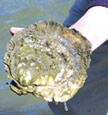 |
|||
|
Volume 12, Issue 23 ~ June 3-9, 2004
|
|||
|
|
Editorial Ariakensis: The Answer or Frankenstein’s Oyster?
When the oysters were retrieved at summer’s end, some — just how many depends on who’s telling the story — were pushed underfoot down into the muck. But the muck didn’t keep them down. “These are good strong animals that pumped themselves out,” said Wesson. “Unaware, they were still doing our test for us and doing very well.” By the time of their rediscovery, the oysters had grown as big as dinner plates, according to the firsthand account of Capt. Bob Jensen, a Virginia oyster-restoration entrepreneur. “That’s not surprising to anybody who’d worked with them,” said Wesson. “They get nice and thick and heavy.” Jensen, who has oystering plans of his own in the tidal pond, is rejoicing, too, claiming that muck-loving ariakensis is just the animal to help make Chesapeake waters fit for native oysters. “This is an animal that will thrive,” he said. Are we ready to pin Chesapeake Country’s oystering future on a creature supersized like a 64-ounce slurpee? Not just yet. We’ve learned a thing or two about ariakensis, but not enough to push Maryland and Virginia sooner toward their shared goal of restocking Chesapeake waters with fertile ariakensis. These ariakensis are so full of surprises they might be the answer. Or they might be Frankenstein’s oyster. |
||
|
© COPYRIGHT 2004 by New Bay Enterprises, Inc. All rights reserved. |

